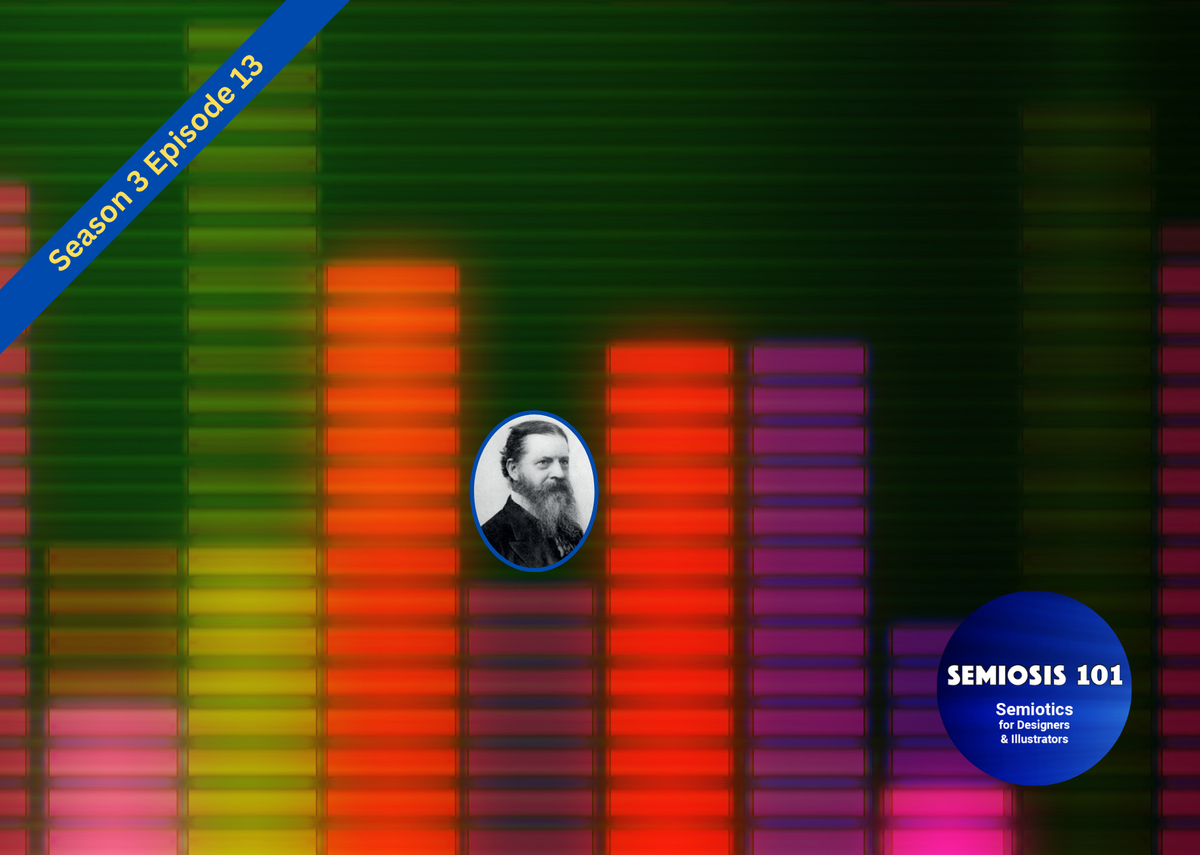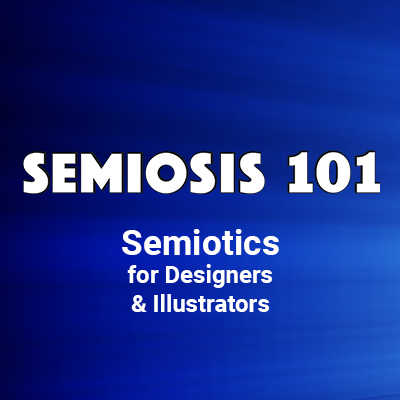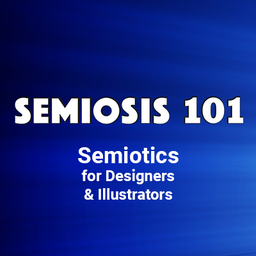Free Semiosis 101 Transcript 3.13:

LEVELS OF INTERPRETATION: Semiotic Framing of Meaning
Hello readers.
In this free transcript for the episode published on Semiosis 101 on Weds 31 January 2024, we discuss how miscommunications can be unintentionally made and how Semiosis offers creatives the semiotic framework to reduce that risk through the semiotic power of threes.
Watch the free episode on YouTube for the full impact…
…and here is the episode’s transcript.
Semiosis - semiotic sign-action - is not passive. As an applied semiotic theory into visual communication work, Semiosis has the power to be beneficial to not only the creative, but also the client, and the clients’ target audience. The possibilities of Rhematic possibility, is pre-existent in the creation of designs and illustrations anyway, whether you realise it or not. Semiosis just frames how to embrace possibility more successfully. Hit subscribe to this YouTube channel, and I will explain…
How can the audience help the creative? Firstly, this is a symbiotic relationship. A win:win:win communicational situation. If the semiotic representation of a concept benefits the client, then its interpretation must also benefit the target audience. If the semiotic interpretation of a concept’s representation has a benefit to the target audience, then the intent behind the visual communication will be also actionable. The creative’s aesthetic… the designed or illustrated visual entity… is a facilitation and not a destination.
Remember, in past episodes I have already stated visual communication is not passive. As design professor Jorge Frascara argues, Visual Communication Design (graphic design and illustration) is a facilitator of behavioural change. Visual communication is proactive. Semiosis - semiotic sign-action - is a pragmatic theory that can be applied to enhance the effectiveness of visual communication.
In the recent episodes we have focussed on the effects on interpretation by semiotic signs. Peirce’s semiotic theory is predicated on the interaction between three states of sign-action. So, before we proceed, as a quick recap let us just consider what these triadic (threes) interactions and inter-relationships are. At a macro level of application of Semiosis into Visual Communication Design, we have the inter-relationship between a client, the creative and a target audience. The client needs the audience to take some action (read this, understand that, go here, buy this, do that, etc.). The creative, whether a designer or illustrator, is commissioned to facilitate this from a client’s brief, through the visual communication work they produce.
But, gone are the days (if they ever existed) when a creative designs a “Buy beans!” poster and the audience passively buys beans. We are not discussing psychologically visually manipulating the target audiences here. Semiotic sign-action, or Semiosis as Peirce names it, is neutral in the intent behind visual communication. As a semiotic theory, Semiosis is concerned with the micro level of perception and communication by the encoding of semiotic signs (no, not signage). Its sign-action power to communicate concepts, is predicated on a determination flow.
This semiotic determination flow, in Semiosis 101 designer-centric terms, is between the concept, its representation, and then interpretation. Peirce uses more obtuse terms instead of these designer-centric terms.
|
PEIRCE |
= |
DESIGNER-CENTRIC |
|
Object |
= |
concept |
|
Representamen |
= |
representation |
|
Interpretant |
= |
interpretation |
Let me quickly put Peirce’s determination flow back into designer-centric contexts. In visual communication, Semiosis is a flow of encoded semiotic signs, as meaning-bearing visual entities (signs) that carry connotational meaning. This involves the audience as a communicational partner. The semiotic determination flow can be understood across the macro or micro levels of what illustrators and designers do in their professional work.
When I describe an illustration or design as a meaning-bearing entity, I am describing its communicational power as both a complete artefact e.g. image, magazine, book, poster, etc. and at the level of the marks, shapes, colours, etc. that a creative uses to design or illustrate it. Every visual communication building block a creative uses has the capability to be meaning-bearing. This fact is important. Miscommunications can be unintentionally made. One thing can be misinterpreted as something not intended.
Semiosis offers creatives the semiotic framework to reduce that risk. It is in this power of threes that Semiosis can help creatives, as this power goes deeper below the semiotic determination flow. At each step in the sign-action, the act of Semiosis is triggered and facilitated across three further levels. What I mean by this is that Peirce’s Semiosis is not just bish, bash, bosh …result! Semiosis is not simply concept > representation > interpretation.
Each of those three steps has three levels underpinning each step’s effectiveness. The semiotic determination flow between a client’s concept(s) to be visually communicated, how the creative chooses to visually represent that concept (i.e. to semiotically encode meaning into the visuals to connotatively communicate a concept), ultimately has to rely on interpretation by the target audience to extract that connotative meaning.
If successfully facilitated, the target audience will gain understanding of the concept. This is far richer and more perceptually subtle than BUY BEANS! But how can this communication be structured? The concept has three semiotic levels, from simple to complex, to aid its communication. So do the representation and interpretation. In seasons one and two we have focused on the three semiotic levels of representation of a concept. These are Iconic representation, Indexical representation and Symbolic representation. We will cover the three levels for communication of the concept in season four in more depth, but the terms Peirce uses to describe their simple to complex power are Qualisign, Sinsign and Legisign.
(I only name check these three terms here as a teaser. If you want to watch season four episodes many months before they appear on YouTube, subscribe on Semiosis 101’s Patreon and become a named Semiosis 101 Producer).
This now leaves us with three levels of how the interpretation is structured. From simple to complex, Peirce names the three levels interpretation is effective as Rheme, Dicent and Argument. Yes, I know. I lead you creatives to an exciting point of new knowledge, a liminal point where your creative mind-set is on the verge of discovering a new point of view …and then Peirce self-sabotages our advancement with more obtuse terminology. Never fear. Semiosis 101 is here! Let us translate what he means in designer-centric terms.
|
PEIRCE |
= |
DESIGNER-CENTRIC |
|
Rheme |
= |
The lower state of possibilities to aid the
audience to perceive the semiotic sign. |
|
Dicent |
= |
The middle state that uses the semiotic representation
to propose the intended interpretation to the audience. |
|
Argument |
= |
The highest state of interpretation that uses the
semiotic sign-action to define the interpretation. |
Let us now end this episode in drilling down to exactly how these are relevant to creatives. Over the seasons, regular viewers will realise that Peirce offers a rich seam of new creative knowledge despite his terminology. When I first encountered these terms I was like many of you right now… completely poleaxed. What, now? Eh? etc. Peircean scholars such as Professor Tony Jappy, helped to break the obtuse language into terms I could begin to parse into creative practice terms. Semiosis 101 is now here to do this more directly for you creatives. Always pay it forward.
So, what in damnation is a Rheme, a Dicent and an having an Argument got to do with semiotically encoding meaning into designs or illustrations? If we look back to what we already know about semiotic representation of a concept, Iconic representation is about resemblances, qualities and familiarity. This is a responsibility of the creative to encode. So if at the lowest level of semiotically encoding representation of a concept is predicated on basic building blocks of recognition, then the Rhematic level of interpretation is the basic effect of that encoding on the audience.
A semiotic sign must first be visually perceived as meaning-bearing to move from a dormant state to begin its sign-action (Semiosis). Once perceived as meaning-bearing the Iconic elements of lines, marks, shapes, colours, etc. suggest something to the perceiver to interpret. The possibilities of what these Iconic lines, marks, shapes, colours, etc. emerge in the mind of the audience, is the first perception level of audience interpretation. This is followed by the perception states where an audience’s interpretation confidently moves from the possible (Rhematical level), to the proposed (Dicent level) and then the defined (Argument level).
The audience is key here. Whatever meaning-bearing the designer or illustrator encodes into their aesthetic visual language, someone needs to decode it. The target audience. Just as Semiosis has three levels of representation sophistication (Iconic, Indexical and Symbolic), it also has three levels of audience interpretation sophistication (Rheme, Dicent and Argument). The Iconic, Indexical and Symbolic are in the creative’s direct control of HOW TO encode, but the audience has the final say HOW they decode (interpret) what is semiotically represented. The effect of the semiotic representation on its interpretation, in the mind of the audience, follows three states of immediate effect, dynamic effect and final effect - all within the determination flow of Semiosis.
Come back next week when we will wrap up the previous three episodes on interpretation before re-examining Peirce’s ten sign classifications.
Semiosis 101 Semiotic Design Resources is a reader-supported publication. To receive exclusive posts and support my work, consider becoming a free or paid subscriber. Paid subscribers get name checked on all future Semiosis 101 YouTube episodes.
===Semiosis 101 Patreon Producer==============
Become a Semiosis 101 Patreon Producer and get a named producer credit on future video episodes, plus watch all new episodes months ahead of YouTube.
===Semiosis 101 Patreon Exclusives==============
Watch longer Patreon-exclusive Semiosis 101 episodes on applying Semiosis into design and illustration…
PATEXC001 How does semiotics work in illustration?





